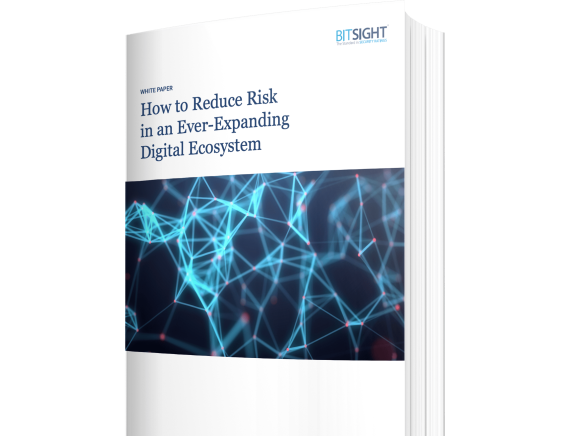With companies racing to achieve digital transformation via the cloud, the Internet of Things (IoT), and bring your own device (BYOD) policies, digital ecosystems are expanding faster than ever. Learn how to protect against threat actors that are taking advantage of new vulnerabilities that are harder to detect.
Reduce the Risk in Your Digital Ecosystem
Tags:

Cyber risk reduction is emerging as one of the most significant issues organizations face when managing their cybersecurity. As digital ecosystems expand, it’s crucial that organizations have insight into their core digital assets and the level of risk present. To improve performance over time, it’s critical to have visibility into your attack surface across various environments. With as much as 75% of the workforce shifting to remote work in some industries, this visibility is more important than ever.
Yet, as digital transformation kicks into high gear, this is exactly what many organizations are struggling to achieve.
In any other part of the organization, if outcomes fail to live up to expectations, teams are held accountable. From sales to marketing to HR, performance management systems and processes are used to measure and reinforce accountability against benchmarks and key performance indicators (KPIs). This hasn’t been the case in cybersecurity, a relatively immature discipline within IT that lacks the tools to demonstrate accountability for measurable cyber risk reduction.
However, now that cyber risk reduction has emerged as a priority for executives, investors, regulators, and customers; accountability is increasingly expected of the cybersecurity function. As a result, security leaders must — like their colleagues in sales, marketing, etc. — find a way to proactively measure, monitor, and manage security performance using data-driven, independent, and objective security metrics.
That’s what Security Performance Management (SPM) delivers: a risk-based, outcome-driven approach that helps security and risk leaders achieve continuous visibility into their expanding digital footprint and digital assets and improve their security posture over time.
The need for continuous visibility into an organization’s digital ecosystem
Even as organizations throw more money at cybersecurity (according to IDC, organizations are expected to spend $151.2 billion on security by 2023), and despite the best efforts of security teams, cyber incidents are on the rise. In a Forrester study, commissioned by Bitsight — Better Security and Business Outcomes with Security Performance Management — it was found that 80% of companies surveyed experienced a security or cyber incident in the past year, the most common being malware attacks.
What does this tell us about traditional approaches to cybersecurity?
1. There is limited visibility across complex digital ecosystems
As digital footprints get larger, they create new points of exposure, making it difficult for security and risk leaders to pinpoint where exactly the greatest cyber risk exists across the entire ecosystem. This is further compounded by the fact that security teams are buried in tools and lack timely visibility across this ecosystem.
2. Understanding context is hard
Faced with a complex toolkit of security solutions and the barrage of information and data they generate, it’s difficult for security teams to discern which events to address first. Lacking important business context — like how critical an asset is to the business, how often the organization is using the asset or who has access to it, and whether it’s hosted on premise or in the cloud — it’s hard to make informed decisions about risk mitigation, such as where to focus remediation or process improvement efforts.

3. Current security programs are not easily scalable
Most organizations do not have enough time or people to adequately monitor the performance of their security programs, particularly as the business scales and their digital footprint expands. This creates visibility gaps that can limit the effectiveness of those security programs and could potentially be exploited.
Faced with these challenges, how do security leaders move forward to change the paradigm of how they operate?
Continuous improvement: Security Performance Management
Security Performance Management is a continuous, risk-based, outcome-driven approach to measuring, monitoring, and managing cybersecurity program performance. It drives accountability for security outcomes throughout the organization and streamlines operations while also ensuring that investments in security controls and resources are efficient and effective.
SPM is focused on continual process improvements
SPM facilitates data-driven, risk-based cybersecurity conversations among key stakeholders that enable teams and executives to drive continual process improvements in their security practice.
With the Bitsight Security Rating as a baseline metric of cybersecurity program performance, security and risk leaders finally have an objective, independent, and broadly adopted key performance indicator (KPI) to continuously and efficiently assess their external security postures, set program goals, track progress, and report meaningful information to executives and the board.
SPM can be applied to any business. For small and mid-size companies, for example, SPM provides an out-of-the-box solution for easily measuring the effectiveness of their growing security programs. As businesses evolve, SPM can help identify where improvements are needed and where to focus security resources.
For the larger enterprise, SPM provides an overarching view into security performance across all digital assets and the effectiveness of controls put in place to protect them — identifying issues and control & visibility gaps in areas of vulnerability management, threat intelligence, and more.
Using this insight, security teams and business leaders can better understand how well their security investments are working for their businesses and identify where processes and tools require improvement. For instance, if SPM identifies unknown vulnerabilities in the security ecosystem, such as unsecured access points or unpatched systems, this might correlate with the need for increased threat intelligence until the issue is resolved.
This leads to increased cooperation among teams and a more actionable understanding of risk, enabling security leaders to make data-driven business decisions that improve the security posture of their organization efficiently and at scale.
Download the white paper to learn how to implement an effective Security Performance Management program.


